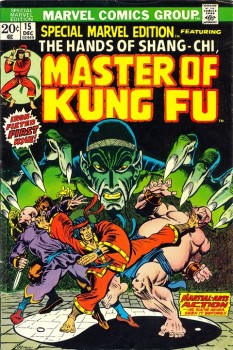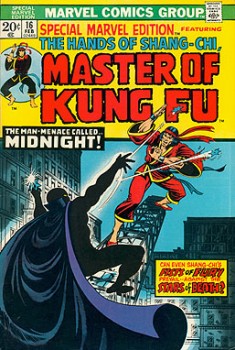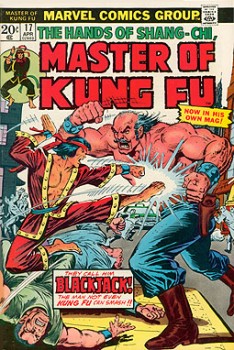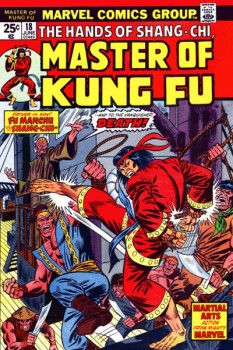Blogging Marvel’s Master of Kung Fu, Part One
 Special Mavel Edition is a little remembered comics reprint title of the early 1970s. Its fifteenth and penultimate issue dated December 1973 featured the debut of a new series, Master of Kung Fu. Marvel’s timing was perfect as Bruce Lee was now a major star at the U.S. box office and David Carradine’s Kung Fu series was a critical and ratings success on the small screen.
Special Mavel Edition is a little remembered comics reprint title of the early 1970s. Its fifteenth and penultimate issue dated December 1973 featured the debut of a new series, Master of Kung Fu. Marvel’s timing was perfect as Bruce Lee was now a major star at the U.S. box office and David Carradine’s Kung Fu series was a critical and ratings success on the small screen.
Marvel had optioned the rights to Sax Rohmer’s Fu Manchu characters several years before when Pyramid paperback reprints of the 13 Rohmer novels were selling strong thanks to the popularity of the Christopher Lee film series. Marvel already had their own Fu Manchu clones in the form of the Yellow Claw and the Mandarin, but Master of Kung Fu gave them the opportunity to build a contemporary martial arts title out of a sequel to Rohmer’s highly influential thriller series.
Conceived by Steve Englehart and Jim Starlin, the decision to incorporate Sax Rohmer’s characters was at the insistence of Marvel editor Roy Thomas. Englehart enlisted the aid of Robert E. Briney, publisher and editor of The Rohmer Review fanzine to ensure the continuity was consistent with Rohmer’s long-running literary series.
Similar to Marvel’s contemporaneous Tomb of Dracula series, the focus was placed on a young adult descendant of an iconic literary villain who teams with the previous generation’s aging heroes to combat the master villainy. In this instance, the descendant was the newly-introduced son of Fu Manchu, Shang-Chi. Debuting as an assassin of the Si-Fan, Shang-Chi’s first assignment is the murder of Dr. Petrie. A fateful encounter with the wheelchair-bound Sir Denis Nayland Smith enlightens the young man that his father, in spite of his genius, is not the honorable man his reputation suggests, but rather a megalomaniac who must be stopped.
 It doesn’t take much to see the established template in use with Fu Manchu as a Dracula surrogate, Shang-Chi as this series’ Frank Drake, and the wheelchair-bound Nayland Smith as a counterpart to the wheelchair-bound Quincy Harker. Much like Tomb of Dracula, it would also take the new series several issues before its distinctive look was captured and its direction began to subtly change to something closer to a martial arts spy thriller. However, Master of Kung Fu shows all kinds of promise from its first appearance to be a unique comics property offering not only martial arts action, but also heavy doses of Eastern philosophy.
It doesn’t take much to see the established template in use with Fu Manchu as a Dracula surrogate, Shang-Chi as this series’ Frank Drake, and the wheelchair-bound Nayland Smith as a counterpart to the wheelchair-bound Quincy Harker. Much like Tomb of Dracula, it would also take the new series several issues before its distinctive look was captured and its direction began to subtly change to something closer to a martial arts spy thriller. However, Master of Kung Fu shows all kinds of promise from its first appearance to be a unique comics property offering not only martial arts action, but also heavy doses of Eastern philosophy.
Despite the involvement of Bob Briney, the first issue’s script does deviate from Rohmer quite a bit. The literary series was reluctant to depict the Devil Doctor as a true villain and Fu Manchu would never break his word as he does here in disregarding his vow to never interfere with any member of the Petrie family again. Rohmer’s widow sought legal recourse by lobbying a complaint with the Society of Authors that Englehart’s changes violated the terms of Marvel’s license. Bob Briney took to the pages of The Rohmer Review to voice his displeasure with the series. However, for an entire generation of young people in the 1970s, Sax Rohmer’s characters were enjoying their last brush with popular appeal before being relegated to a cult following among pulp enthusiasts.
Pulp is definitely the focus of the series’ second appearance in Marvel Special Edition #16 with the introduction of Midnight, a character clearly inspired by the legendary pulp character, The Shadow. Interestingly, Englehart sought inspiration from the other vital exploitation market of the early 1970s, Blaxploitation by making Midnight an African orphan adopted by Fu Manchu and raised as Shang-Chi’s brother and fellow Si-Fan assassin.
Pitting martial arts and Blaxploitation against one another in the trappings of pulp fiction was admittedly an inspired decision. Fu Manchu is relegated to a supporting role as the puppet master behind Midnight, but this is actually closer to how Rohmer positioned the character in his novels. Sir Denis Nayland Smith does not appear, but readers are aware that Interpol has contacted U.S. law enforcement agencies to track down Shang-Chi and bring him to justice for the assassination of Dr. Petrie. A simple matter such as leaving Midnight with a broken neck was hardly an assurance that readers had seen the last of this intriguing character. Nayland Smith’s return was promised in the next issue which would move the premise established in the first issue forward to set the series in motion.

 Issue #17 saw Special Marvel Edition change its title to Master of Kung Fu. This issue and the one following did much to set the direction of the series now that the characters and premise had been firmly established. Issue #17 would be Jim Starlin’s last for the series with Paul Gulacy taking over with Issue #18.
Issue #17 saw Special Marvel Edition change its title to Master of Kung Fu. This issue and the one following did much to set the direction of the series now that the characters and premise had been firmly established. Issue #17 would be Jim Starlin’s last for the series with Paul Gulacy taking over with Issue #18.
Sir Denis Nayland Smith has relocated to Long Island and is staying at the home of a fellow retired agent of the British Foreign Office, Black Jack Tarr. The latter has styled his home the Murder Mansion. The parallel with Fu Manchu’s Manhattan-based operations is deliberate for the obsession men such as Smith and Tarr harbor for the Devil Doctor has robbed them of their sanity and decency and blurred the line between good and evil. This theme is one that will continue to resonate across the series for the next decade.
The critical outcome is that in helping Sir Denis find the strength to stand again, Shang-Chi begins to rehabilitate the embittered colonialist. The situation is handled with commendable realism with Sir Denis still reluctant to leave the safety of his wheelchair and initially desiring to have Shang-Chi join him in his war against Fu Manchu just as the Devil Doctor initially deployed his son as a living weapon.
The second half of the storyline, Mr. Gulacy’s debut as artist, moves at a breakneck pace, but gives us a truly epic scope that foreshadows the greatness to come for this series. Fu Manchu (reunited with Peko the marmoset at last) cruelly dispatching an unsuccessful dacoit so that the man’s final hour sees his frenzied battle to the death against a bound Shang-Chi is overwhelmed by the unexpected scale of Shang-Chi’s miraculous act of sabotage against his father’s superior resources. The ending literally leaves readers gasping in shock and eager to see what the next issue (Steve Englehart’s last with the series) will bring.
William Patrick Maynard is the authorized continuation writer for the Estate of Sax Rohmer. His third Fu Manchu thriller, The Triumph of Fu Manchu will be published by Black Coat Press later this year.
Never made the connection with Tomb of Dracula so that was an interesting insight. Englehart got off to a great start but Doug Moench made it his masterpiece along with Paul Gulacy and later Gene Day. To me Fu Manchu works best in the background (while one can never get enough of Doctor Doom by way of contrast).
Interesting article. I don’t know if its just chance, but Marvel is releasing Master of Kung Fu volume 1 omnibus tomorrow.
It contains Special Marvel Edition 15-16, Master of Kung Fu 17-37, Giant Size Master of Kung Fu 1-4, Giant Size Spider-man 2, and material from Iron Man annual 4.
Freud says there are no coincidences.
This was one my series even thought I got to it the much later issues.
Bruce Lee and Martial Ars was just so cool in the 70’s and these comics fit right into that trend. I could easily see the Master of Kung Fu being a series of Martial Arts action movies starring Lee himself.